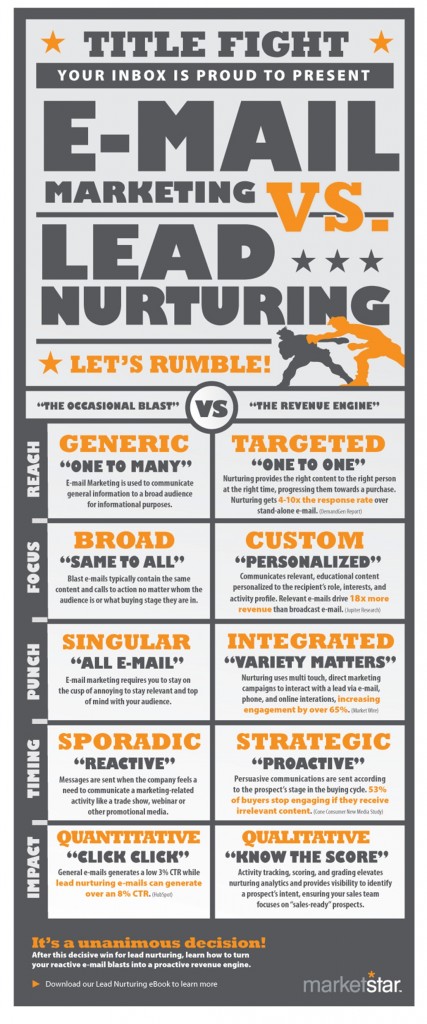{Video} Nonprofit: Email Marketing vs. Nurturing
Today we are going to talk about the difference between email marketing and email nurturing for your nonprofit organization. The very first point I’m going to say and the last thing I want you to remember is that email marketing done right IS email nurturing. Let’s take a look at the difference between the two.
Email Marketing vs. Nurturing
 The first difference is reach. Email marketing in the traditional sense is what you and probably most other people think of: you send one message to everyone on your list. It is a one-to-many style of communication. Email nurturing on the other hand is a one-to-one kind of communication where you are giving the right information to the right person at the right time.
The first difference is reach. Email marketing in the traditional sense is what you and probably most other people think of: you send one message to everyone on your list. It is a one-to-many style of communication. Email nurturing on the other hand is a one-to-one kind of communication where you are giving the right information to the right person at the right time.
Segment Your Audience
Now, obviously this is a much more complicated way to handle your email marketing, but HubSpot has a data point that shows you get a 1% increase on your click-through-rate just by having between two in six lists over organizations with only a single list.
Segmentation is crucial. Let’s talk a little bit about what segmentation means. If you’re keeping a single list for your nonprofit organization and you are sending the same message with the same calls to action and content to everyone on that list, then you are failing miserably at email marketing. I hate to be the bearer of bad news.
What you need is a list for people who’ve donated to you. You need a list for your volunteers. You need a list for people who have shown some interest and maybe attended an event but have never actually made a donation.
You need to segment these people out because the kind of information that you would send to someone who has come to an event, but not donated or become a member is completely different from the kind of information you should be sending your active donors or your volunteers.
Audience Focus: Email Marketing Doesn’t Have It
The next way they are different is in focus. Email marketing has a very broad focus because you are sending the same info to everybody. How focused could it be? Email nurturing is very custom. You are sending that specific message to that specific audience with a hope of a very specific outcome. Should you email the people who came to an event but never donated with a donation message, the end result you are hoping for is to get that donation.
Developing Your Plan of Action
The final difference is email marketing is very sporadic. Email nurturing is strategic. An email marketing strategy involves:
- Defining your audiences
- Defining the messages each audience will receive
- Defining a schedule for which your audience will receive your messages
Sending out an email whenever you have something to announce to your entire list is a very reactive and sporadic way of handling your email marketing. Everybody seems to have the Facebook bug and want to be involved in social media, but email marketing is alive and well.
What is Your Best Option?
A 2011 research survey the DMA completed showed an average of 4,000% return for every dollar spent on email marketing. So, double down on email marketing for your organization, figure out how you can become more strategic and define email nurturing campaigns instead of email marketing because I’ll say it again:
Email marketing done right IS email nurturing.







Hi James, thanks, great summary. As a nonprofit marketing person who wears a lot of hats, short and sweet overviews are essential. Keep ’em coming! The thing that immediately pops into my head is… do I have the time (and money) to do a more nurtured approach? (for us, email marketing isn’t a revenue generator, so it can’t easily pay for itself with more donations etc)
I guess I would say that even if email marketing isn’t a revenue generator, it’s still your most targeted and cost-effective communications channel. That’s just one more reason that you should focus on creating email marketing systems that can properly convey your message without you having to invest time every month. Focusing on systems is even more crucial when time and money are tight. Build it once, and let it run.